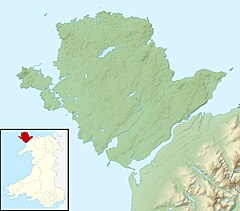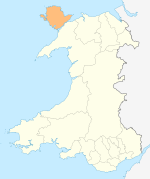| Afon Cadnant | |
|---|---|
 Clapper bridge over Afon Cadnant | |
Location on Anglesey | |
| Location | |
| Country | Wales |
| Physical characteristics | |
| Mouth | Menai Strait |
The Afon Cadnant (English: River Cadnant) is a small river on Anglesey, North Wales in the United Kingdom, which drains to the Menai Strait about 1 km north-east of the Menai Suspension Bridge. The river drains a largely agricultural area from Llandegfan to Llansadwrn and beyond, with feeder tributaries extending up towards Pentraeth forest.
Within the catchment are some artificial fishing ponds and a number of beef and dairy farms.
More notable are the remains and ruins of a number of water mills, especially in the lower section before the river enters the strait. Up until the end of the 18th century it appears that great efforts were made to extract all the energy from the river to grind corn. This reflects the history of Anglesey as the bread-basket of Wales.
Cadnant Dingle
[edit]The lower section known as Cadnant Dingle is a steep sided densely wooded valley with very restricted access. It is a designated SSSI as a representative example of the Brachypodium sylvaticum, Oak / Ash (slender falsebrome oak/ash) group of broadleaved woodlands.[1]
Within the dingle and on the adjacent land is Plas Cadnant, an historical estate now noted for its extensive gardens.
At the mouth of the river there is a small group of houses called Cwm Cadnant below which is a modern bridge carrying the main road to Beaumaris. Before the construction of the Menai Suspension Bridge, this was an important landing stage for boats carrying milled corn to the mainland. It was also the staging place for the Bishop of Bangor as he moved between his palace at Glyn Garth on Anglesey and his cathedral at Bangor.
Further upstream from the old bridge there is an old smithy, a few workers cottages and a slate mill dating from 1820.
References
[edit]- ^ "Cadnant Dingle SSSI". CCW.gov.uk. Archived from the original on 6 June 2014. Retrieved 18 October 2012.


Well, that’s interesting to know that Psilotum nudum are known as whisk ferns. Psilotum nudum is the commoner species of the two. While the P. flaccidum is a rare species and is found in the tropical islands. Both the species are usually epiphytic in habit and grow upon tree ferns. These species may also be terrestrial and grow in humus or in the crevices of the rocks.
View the detailed Guide of Psilotum nudum: Detailed Study Of Psilotum Nudum (Whisk Fern), Classification, Anatomy, Reproduction